Menu
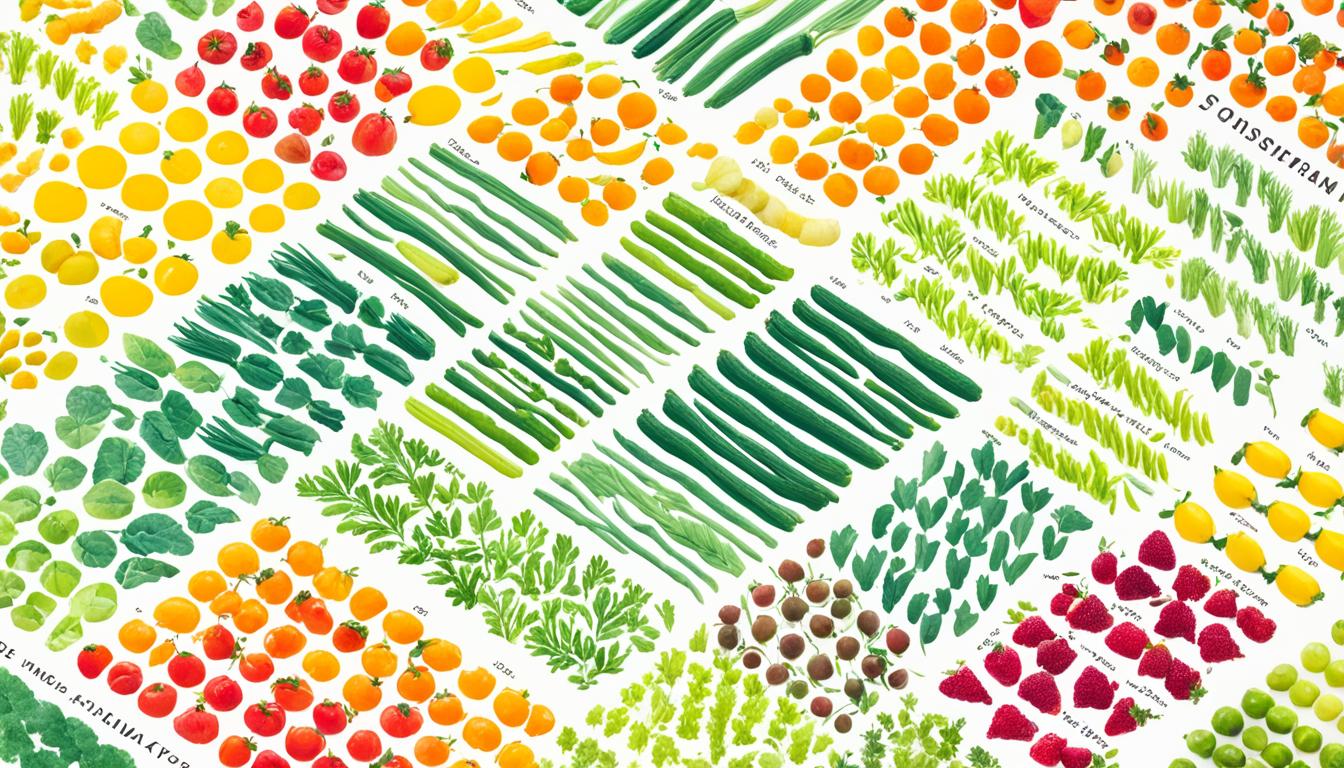
Did you know the farm management software and data analytics market was worth USD 3.61 billion in 2022? It’s expected to grow to USD 12.79 billion by 2031. This shows how farm market analytics are changing farming.
The farm industry is quickly changing due to high investments and new technologies. Devices like GPS, GNSS, and drones are making farms work better and greener. They help farmers with new tools that give smart advice. This makes their work better and helps them grow more food. But, not everything is easy. Keeping data safe and making sure everyone can use these new things are big challenges.
Farm market analytics uses smart tools to make farming better. These tools help with problems like bad weather and tired soil. They use weather data to decide when to plant so crops do well and prices stay stable, even if droughts or floods happen.
New tech like GPS and GNSS is changing how we prepare land. In the Midwest, 2019 was wet, which hurt corn and soybean crops. Smart tools gave farmers tips in real time to help reduce the harm from bad weather.
Using drones is also key in watching how crops grow. They help pick good bugs to eat the bad ones in strawberries, or they add special plants to make the soil better in India. This shows how tech is useful in many types of farming.
How countries trade affects farm prices too, like when tariffs make crops cost more. The US and China’s disputes also change who can buy what crops. This shows that worldwide deals have a big effect on farming.
More detailed farming knowledge is now really important. Like, studying farmers’ markets in Oregon between 2002 and 2005 found most people joined in when asked. This shows how choosing the right info can really help understand what people need and buy.
Keeping farmers’ markets well-organised is as important. Places like Pennsylvania and Oregon have different ways to run markets, with strict rules. This helps make sure markets run smoothly and everyone gets what they need.
In the end, using smart analytics and new farming ways are changing the game for farmers. By using data on weather, land, and watching crops, farms can do better and produce more.
The world of farming is changing fast thanks to new tech. With more people to feed, our food demand will increase by 70% by 2050. Modern farms are starting to use smart techniques. The aim is to keep crops healthy and produce more with less.
Farms now rely on cameras and sensors for many jobs. They check on soil and crops, plus keep an eye on how machines work. Take Robert Salmon, a farmer in the UK, for example. He’s using special tech to make sure his fields and machines work in the best way. This smart farming makes sure no resource is wasted.
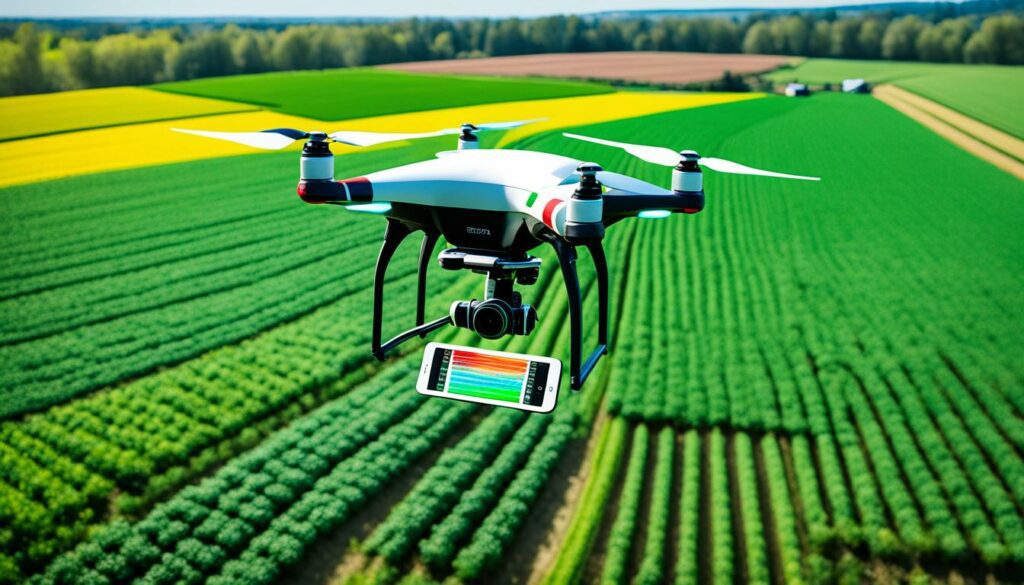
Drones and UAVs are a big deal in farming. Their market is set to jump from $1.1 billion in 2022 to $7.19 billion by 2032. These flying helpers give farmers an overview of their land. They’re great for spotting problems like bugs or lack of nutrients early. This means farmers can act quickly to save their crops.
GPS and GNSS are making farming more accurate. By accurately mapping fields, they help farmers focus on plants that need extra care. This lets them use less but get better results. In Europe and North America, over 60% of farms are already using these smart tools. The global market for precision farming could hit $16.35 billion by 2028. These stats show how important GPS and GNSS are for the future of farming.
The agriculture analytics market is growing fast with huge investment and new ideas. It was valued at USD 5.35 billion in 2022 and is expected to grow by 13.5% every year from 2023 to 2030.
Recent market research reports show the global agriculture analytics market is expanding quickly. It started at USD 5.35 billion in 2022. The increase comes from using more advanced tech and the greater need for food because of a growing population. The market is set to grow by 13.5% each year from 2023 to 2030.
The increase in farm analytics growth projections is mainly due to some key reasons. For instance, precision farming, which made up 46.96% of the market in 2022, plays a big role in this growth. Also, the services part, which took 42.81% of the market in the same year, is important.
There’s quite a good level of innovation in this market. On top of that, a lot of companies are focusing on making real changes that farmers can use. This trend is leading to more market research reports that are very detailed and helpful. So, people keep investing in the agriculture sector.
| Year | Market Size (USD Million) | Y-O-Y Growth (%) |
|---|---|---|
| 2020 | 4,200 | 12.3% |
| 2021 | 4,723 | 14.8% |
| 2022 | 5,350 | 13.3% |
Data is changing the game in farming, making operations better and more sustainable. By using insights from data, farms can improve their efficiency a lot. For example, with data on the weather, farmers can plan better. They know when to plant crops and when to protect them from bad weather. Monitoring crop growth can also help farmers. It gives them information on when to step in to improve their harvests and crop quality.

Farming today relies a lot on weather data analytics. Thanks to accurate weather forecasts, farmers can decide when best to plant, water, or harvest. This saves resources like water and crop protection products. It also makes farming more efficient by giving farmers access to the latest weather data, often on their phones. This helps them make smarter choices fast.
Monitoring crop growth is key to big harvests and great quality food. With high-tech sensors and big data, farmers can watch over their crops all the time. Adding sensors to fields and sharing data lets farmers target their efforts. This strategy boosts efficiency and helps spot crop problems early. It also guides how they use their resources, making farming smarter.
DTN and SMAG InVivo, for example, are showing how important data is in farming. They use data for precision farming, leading to more money and better crops. As the use of data in farming grows, its role in making farms work better will only increase.
| Key Benefits | Impact |
|---|---|
| Targeted Crop Advice | Enhanced decision-making and crop management |
| Efficient Resource Use | Reduced waste of water and fertilisers |
| Market Insights | Better understanding of supply and demand trends |
| Early Identification of Plant Stresses | Timely interventions to mitigate issues |
| Regulatory Compliance | Facilitated adherence to agricultural regulations |
The adoption of farm analytics solutions faces many hurdles. These include data privacy worries and the lack of proper infrastructure. Tackling these challenges is key to enjoy the full advantages of new farming technologies.
Data privacy is a big issue in picking up farm analytics. With more software and hardware being used, protecting information is vital. Essential farm data like crop details and livestock numbers must stay safe. In 2021, investments in agriculture tech hit $18.2 billion. So, we need strong measures to guard these precious datasets.
Many farmers face a barrier in understanding tech. This is especially true for those in far-off or developing places. They lack the skills to fully exploit advanced farm analytics. Education and training are crucial for them. A survey found that only 61% of farmers in Europe and North America are using agtech. But, in other parts, the lack of know-how holds back this adoption.
In many places, poor infrastructure worsens the problem. Things like reliable internet and power are not always there. This makes it harder for farmers to use advanced tools. Large and small farms also face differing challenges. While 81% of big farms are ready to use agtech, only 36% of small farms are. Overcoming these hurdles is vital to help all farmers and level the playing field worldwide.
Precision farming keeps getting better to meet global agriculture’s needs. Now, it’s all about using resources wisely and managing water well. By 2031, this sector is expected to grow a lot, thanks to new tech and the push for saving resources.
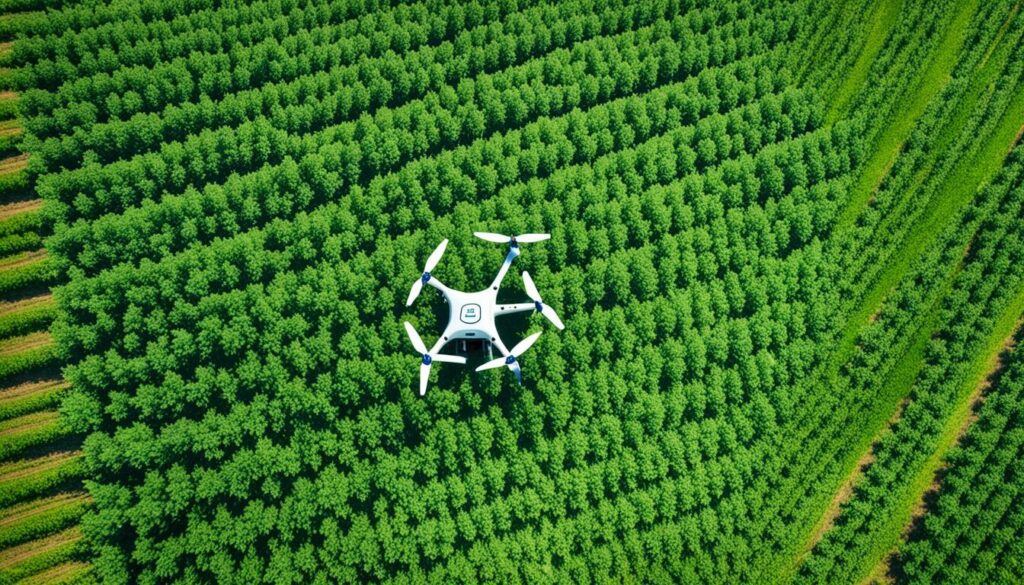
Advanced sensors and smart software help farmers use resources better. They give instant data and tips to use fertilisers, water, and pesticides carefully. This not only boosts the crops but also cuts down on wasted resources, which is good for the planet. Companies like Deere & Company and SST Development Group are at the forefront of this technology.
Systems for precise irrigation are gaining popularity. They check soil moisture, figure out how much water plants need, and give just the right amount. This saves water and helps plants grow better. With water shortages and environmental worries, these solutions are key for farming now. Big players like Agribotix Llc and Leica Geosystems are working together to make this happen, showing a bright future for farming technology.
| Company | Key Focus Area | Technological Contribution |
|---|---|---|
| Deere & Company | Resource Allocation | Sensors and Analytics |
| Leica Geosystems | Water Management | Precision Irrigation Systems |
| Monsanto Company | Crop Monitoring | IoT and Data Analytics |
| Garmin International | Field Mapping | GPS Technology |
| Agribotix Llc | Irrigation Management | Drone Technology |
Regulatory frameworks in agriculture analytics have a huge effect. They set the rules for handling data in farming, keeping it safe. Following data protection laws in farming is vital. It helps analytics firms gain and keep trust with farmers and others.
Agriculture, farm, or farming were mentioned 135 times in the UK’s report on stopping global warming.
The numbers show how important these rules are. From 1995 to 2017, the world saw 2.34 billion hectares of GM crops. The United States and Brazil made up 65% of this in 2019. This shows that only a few countries use most of the GM crops because of strict rules.
Though the rules change, they all focus on making food safer and the earth greener. The EU’s Green Deal aims for no greenhouse gas emissions and sustainable growth by 2050. Canada’s plan for 2023-2028 looks at climate change and new farming methods.
Countries have their unique ways of dealing with farming challenges:
| Country | Key Initiatives |
|---|---|
| United States | Farm Bill, renewed every five years, looks after farm earnings, nature care, and food quality. |
| Brazil | Support for family farms, insurance, and bio-farming inputs. |
| India | Water and traditional farming development. |
| China | Backs projects for long-term growth with subsidies. |
We’re always making new things in farming. Knowing and following regulatory frameworks in agriculture analytics and data protection laws in farming is key. This way, we move forward in tech and keep the farming world safe and sustainable.
Sustainability is becoming a big deal in farming. It’s important for keeping the environment healthy, making money, and promoting fairness. We’re focusing more on key environmental measurements and making farming more traceable. This leads to better and more green ways to produce our food.
Environmental KPIs look at how farming affects the planet. Sustainable farming aims to use less land, save natural resources, and stop pollution. For example, using drip irrigation can save up to 40% more water. It also boosts crop growth by as much as 50%. No-till farming is another great method. It reduces soil erosion and compaction, helping the environment stay steady.
| Sustainable Practice | Environmental Impact | Benefits |
|---|---|---|
| Drip Irrigation | 20-40% Less Water Usage | 20-50% More Crops |
| Cover Crops | Reduced Soil Erosion | Enhanced Organic Matter |
| No-Till Practices | Prevents Soil Loss | Reduced Soil Compaction |
| Integrated Pest Management | Minimal Harm to Environment | Reduced Chemical Usage |
Traceability in farming makes each food’s journey clear, from where it’s grown to your plate. This open process is very important to people who want to eat food that was made with the planet in mind. By tracking data on the farm, we can make sure what we eat is really good for us. Improving how we tackle weeds using tougher plants and machines also helps us farm more sustainably.
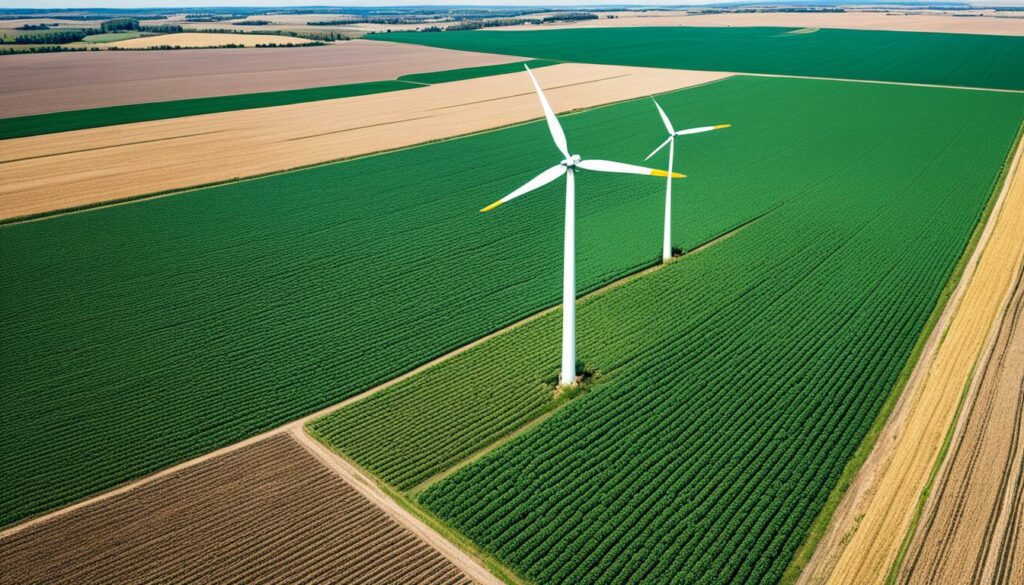
Going green in farming is not just about the planet. It also helps the economy and brings fair living for everyone. Take integrated pest management, for instance. It uses natural ways to fight pests, cutting down on harmful sprays by 30%. This is not only good for our environment but also for keeping us healthy. More and more, there’s a push to farm in ways that will not hurt the earth for those who come after us.
The COVID-19 pandemic has had a big effect on farming. It led to problems in getting products to people and made farmers turn to greener ways of working. This change has happened all around the world, changing how food is produced and sold.
The first problem was with moving products from farms to stores. This caused big changes in the market. More people started buying food to make at home instead of eating out. There was also a jump in the amount of pork sent to China, trying to make up for the pork they couldn’t produce because of a disease.
Efforts like the Paycheck Protection Program and the Coronavirus Food Assistance Program helped American farms. They put in $29.3 billion to keep them going during the tough times.
More and more, farmers are focusing on ways to grow food that’s good for the planet. We saw this pay off in 2023 when global food safety got better. This good news was because more people had money and the cost of vegetable oil dropped.
There’s also a push for food that we can track from the farm to the table. This helps us know where our food comes from. Even though some people in the U.S. had trouble getting enough food in 2022, these greener ways of farming are a positive change.
| Key Metrics | Data |
|---|---|
| USDA National School Lunch Program Meals (Since 1971) | 229 billion |
| Pork Exports Surge to China | Due to African swine fever |
| Paycheck Protection Program (2020) | $5.8 billion |
| Coronavirus Food Assistance Program (2020) | $23.5 billion |
| Decrease in Food-at-home Spending | Close to pre-COVID levels |
| Food-away-from-home Spending | Remains high |
| Improvement in Global Food Security (2023) | Higher incomes, lower vegetable oil prices |
Agriculture analytics is a fast-paced field where key players are always on the move. They focus on strategies to grow their influence in the market. We will explore their steps in forming new partnerships and alliances. These actions impact how the market looks and operates.
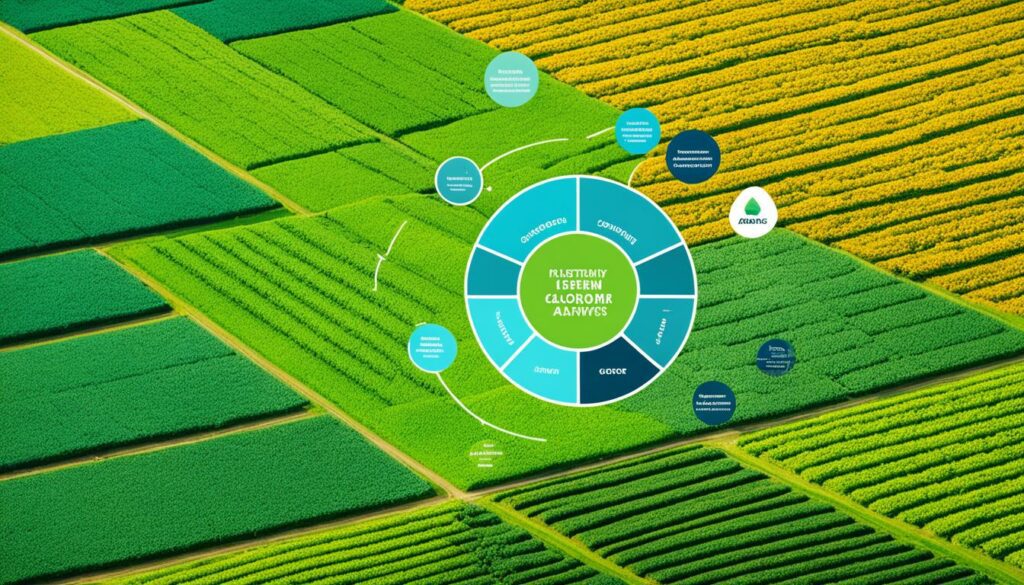
Big names like IBM and Bayer join forces in the agriculture analytics market. They aim to improve farming by using advanced tools. This combination of tools helps farms run better. It deals with problems like using resources smarter and making predictions.
Companies like John Deere and Climate Corporation are also working together. Their aim is to provide farms with the best data-driven solutions. These partnerships make new technologies more available. It builds a strong network for everyone in the agriculture analytics field.
Studies show the agriculture analytics market has a fair level of focus. This means it’s not spread too thin but could face risks if it relies on only a few clients. Still, having a wide range of services can give a company an edge.
| Company | Number of Patents (2013-2023) |
|---|---|
| IBM | 150 |
| Bayer | 120 |
| John Deere | 95 |
| Climate Corporation | 85 |
Having a lot of different clients helps lower risks from market focus. It also encourages steady business growth. By serving many kinds of farms, companies avoid being too affected by one change. Using market reports wisely, these businesses keep ahead in agriculture analytics.
In farming, using advanced analytics leads to better crop predictions and live monitoring. Farms now boost their output and work smarter thanks to these tech tools.
Farmers use AI for figuring out how much they’ll grow each season. IBM’s Watson helps by analysing weather and soil data. This prevents crop losses by optimising planting and care processes.
With IoT sensors and AI, farmers check their fields and animals all the time. Nestlé tracks soil to stop pests and sickness quickly. This keeps crops healthy and cuts down on losses.
Drone mapping also helps by spotting problems early. This allows farms to use water and other resources better. They can react swiftly to protect their plants and animals.
These insights show how vital data is in farming today. As more farms use these tools, they’ll grow more food in eco-friendly ways. This helps tackle the challenges of feeding a growing world and dealing with climate changes.
The global farm market analytics scene is rich and varied. It’s shaped by economic growth, tech skills, and how well areas are connected. Looking at regional adoption rates shows us that each place is different. They don’t just vary in taking up new tech. Their market activities are also unique.
How fast market analytics are picked up changes a lot by region. Places with strong tech abilities and good infrastructure, like in North America, adopt quickly. They use advanced farming methods, like looking at farms from space. But, regions such as Latin America and parts of Asia find it hard to use these advanced tools. They face problems with not having enough educational support and infrastructure.
Taking a close look at agriculture market differences shows each area growing differently. For example, in Europe, laws support eco-friendly and tech-based farming. On the other hand, places like the Middle East & Africa see slower growth. They mainly invest in tech to make sure there’s enough food for everyone. But, they struggle with not having the right infrastructure for these efforts.
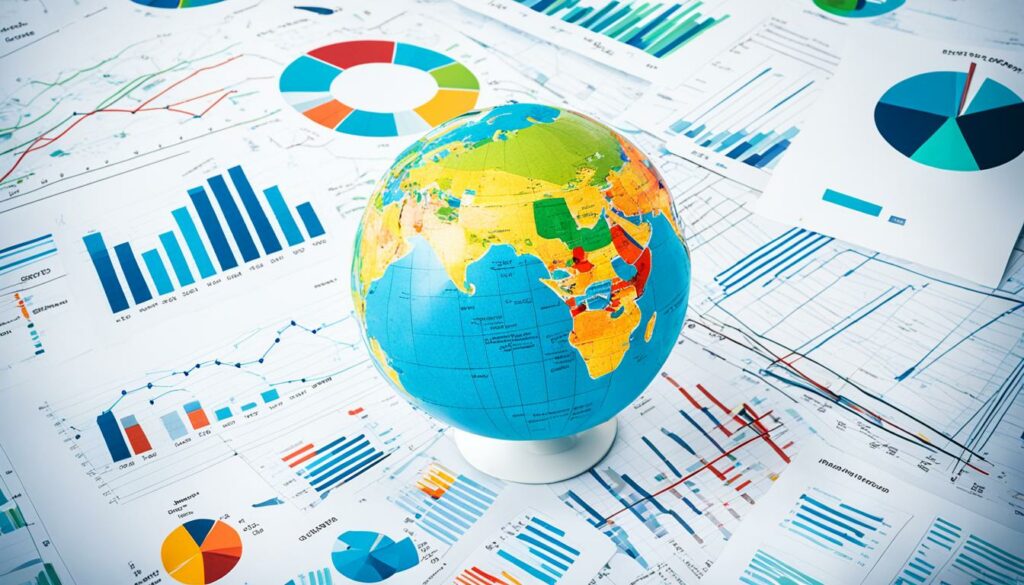
This picture gives us a good view of how regions differ in farming trends. It’s based on the latest information.
| Region | Adoption Rate (%) | Key Factors |
|---|---|---|
| North America | 70% | Technological literacy, infrastructure |
| Europe | 65% | Regulatory support, sustainable practices |
| Asia Pacific | 50% | Economic growth, varied developments |
| Middle East & Africa | 40% | Food security investments, infrastructural challenges |
| Latin America | 45% | Infrastructural barriers, emerging markets |
The differences in how quickly areas adopt farm analytics show a complex mix of growth chances and difficulties worldwide. Knowing these details helps us aim investments and tech improvements for the specific needs of each place.
In the years leading to 2050, farming will greatly change. There will be a big increase in food needed, about 68 percent more. This is because the world’s population is growing. Technologies such as artificial intelligence and blockchain will help meet this food challenge.
Artificial intelligence will change how we farm. It will provide smart predictions and immediate data. The AI market in farming is expected to jump from USD 1.7 billion in 2023 to USD 4.7 billion by 2028. This shows how impactful it will be.
AI drones will help spray pesticides intelligently. They will aim to use just enough to be effective. Companies like CattleEye help farmers understand how diet and the environment affect their animals. AI makes it possible for farms to run themselves in ways. It can manage crops in smart greenhouses by adjusting factors like temperature, humidity, and light. This helps plants grow better.
Blockchain will make farming more transparent and trusted. It shines a light on food’s journey, from making to buying, ensuring safety and quality. Blockchain boosts the quest for sustainable meat by tracking it back to its source. This helps to meet strict regulations. For example, Singapore allows cultured meat to be sold, and Beyond Meat has done very well. Also, blockchain fights fraud, saves money, and makes consumers more confident. It does this by creating an unchangeable record of the food chain.
These emerging farming technologies show the sector can grow and meet tough challenges. By using AI and blockchain, farming will become more efficient and honest. This will lead to a better future for farming and the environment.
As I look back on what we learned, the heart of farm market analytics becomes clear. This area keeps changing, and what we’ve found shows how it’s key for farming’s future. Looking through the lens of farm market analytics, we see tech is vital for its progress. In Oregon, 94% of the farmers’ markets took part in a big survey. This shows they’re turning to data more and more.
29 market managers from six groups took part, looking at 33 markets. They showed how working together is at the heart of this field. Using software like the Statistical Package for the Social Sciences (SPSS) version 11.5, they dug into how these markets run. They found that market managers do a lot, from setting up to keeping things safe. They adjust their tasks based on their market’s size. This shows how they can handle all kinds of work, agreeing on what to do with farmers.
Good rules and regulations are crucial for running farmers’ markets well. They’re the foundation for the success seen in Oregon’s markets. To sum up, bringing together data has been key for understanding market trends. This mix of technology, rules, and the focus on being green will keep helping markets grow. It also helps them face challenges and make the most of chances worldwide.
Farm market analytics are changing fast. Middle School They’re expected to grow at 13.5% every year. This growth is from 2023 to 2030. Tech like GPS, GNSS, and drones is getting a bigger role. They’re helping farmers make better choices. This tech aims to make farming better and to get higher crops.
New tech is making farming more efficient. Things like sensors, cameras, and drones are adding to farmers’ tools. They use GPS for more accurate farming. All this high-tech stuff allows for precise farming. It also means farmers can keep an eye on their crops all the time. And they can manage their resources much better.
In 2022, the market for farming analytics was worth USD 5.35 billion. It’s growing fast at 13.5% each year. This growth continues till 2030. Driving this growth is new tech and more demand for food due to more people needing to eat.
Data analytics are key in making farming better. They give farmers insights into the weather and their crops. This helps them get ready for different weather. It also means they can look after their crops in a smarter way. This can lead to higher crop yields and less wasted resources.
Challenges to using farm analytics include worries about data safety. Not all farmers are clued up on new tech. And some places don’t have the infrastructure to use these systems. These things slow down the spread of farm analytics.
In precision farming, trends are about using resources better and managing water more carefully. Things like sensors and smart software are making this possible. This smart use of resources can mean more crops grown and less waste.
Laws about data safety have a big say in the farming analytics market. It’s very important for analytics companies to follow these rules to stay trusted. Trust in these solutions is key to keeping the market strong.
Today, farming is working harder to be good for the planet. It’s all about meeting eco-goals and being clear about where food comes from. By collecting data on how they farm, growers can make food in a better way. They also tell us more about how the food chain works.
COVID-19 has messed up the food chain and made it hard for some food businesses. But, we see more farms turning to eco-friendly ways of farming. This has made the industry stronger against more hard times.
In the world of farming analytics, working together and sharing ideas is big. Success here is about how many clients analytics firms can get. It’s also about the range of jobs they do. Being creative is also important to stand out.
Using analytics can help farmers guess how much they’ll grow. They can also watch their farms in real time. Big names like IBM and Nestlé are already using this to make farms better and greener.
Not everywhere is quick to pick up on farming analytics. This can be due to different levels of development and tech know-how. In general, richer places are faster at using these techs. Poorer areas might struggle more.
Next up is using AI and blockchains more in farming analysis. These new tools want to make farming even more efficient. They’re all about using data in the smartest way to help farmers make good choices.